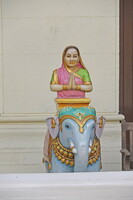| dc.coverage.spatial | Site: Malabar Hill (Mumbai, Mahārāshtra, India) | en_US |
| dc.coverage.temporal | 1904 (creation) | en_US |
| dc.creator | unknown (Indian (South Asian)) | en_US |
| dc.date | 1904 | en_US |
| dc.date.accessioned | 2016-06-21T19:11:14Z | |
| dc.date.available | 2016-06-21T19:11:14Z | |
| dc.date.issued | 1904 | en_US |
| dc.identifier | 264822 | en_US |
| dc.identifier.other | archrefid: 3384 | en_US |
| dc.identifier.uri | http://hdl.handle.net/1721.3/180880 | |
| dc.description | Smaller carved elephant flanking inner temple doorway; Jainism has been present in Maharashtra since ancient times. The oldest inscription in Maharashtra is a 2nd-century BCE Jain inscription in a cave near Pale village in the Pune District. The word "Jain" derives from the Sanskrit word jina "victor". A human being who has conquered all inner passions and achieved enlightenment is called a jina. The temple is dedicated to Adishwar (also known as Adinath or Rishabdev), the first of 24 Jain Tirthankaras (jinas, enlightened beings) of the current era. The temple is used by thousands for their daily worship. Source: Wikipedia; http://en.wikipedia.org/wiki/Main_Page (accessed 8/16/2015) | en_US |
| dc.format.medium | stone; marble; wood; paint | en_US |
| dc.rights | © Scott Gilchrist, Archivision, Inc. | en_US |
| dc.subject | architecture | en_US |
| dc.subject | deities | en_US |
| dc.subject | Jainism | en_US |
| dc.subject | Twentieth century | en_US |
| dc.title | Babu Amichand Panalal Adishwarji Jain Temple | en_US |
| dc.type | image | en_US |
| dc.rights.access | Licensed for educational and research use by the MIT community only | en_US |
| dc.identifier.vendorcode | 1A2-IN-M-JT-A33 | en_US |
| vra.culturalContext | Indian (South Asian) | en_US |
| vra.technique | carving (processes), construction (assembling), painting and painting techniques | en_US |
| vra.worktype | temple | en_US |
| dc.contributor.display | unknown (Indian (South Asian)) | en_US |

